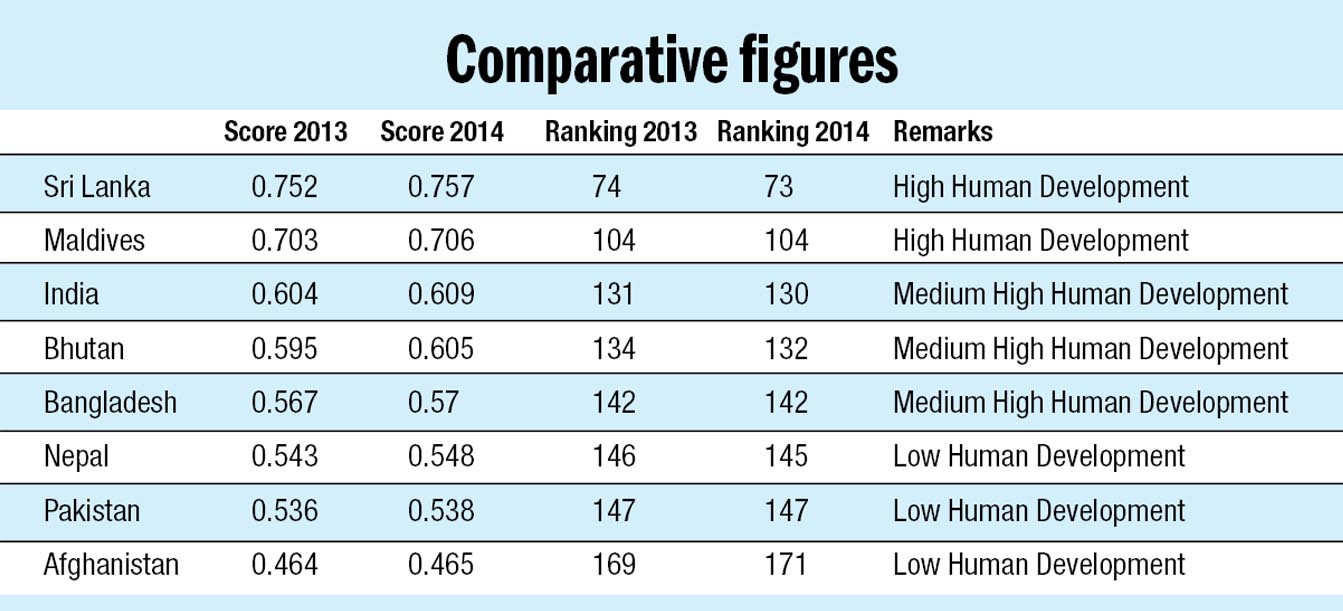Nepal’s HDI ranking improves moderately to 145: UN
Kathmandu, December 15
Nepal’s ranking in the global Human Development Index (HDI) has gone up by a notch, indicating slight improvement in wellbeing and basic education attainment of Nepalis.
Nepal ranked 145th in HDI in 2014, with a score of 0.548, as against 2013’s ranking of 146 and a score of 0.543, shows the 2015 Human Development Report launched this week by the United Nations.
HDI scores and rankings are determined based on average achievement in three basic dimensions of human development — a long and healthy life, knowledge and a decent standard of living.
Although Nepal’s human development score and ranking improved in 2014, it lagged behind many countries in South Asia because of slow progress in key areas.
Nepal may fall further behind next year when impacts of earthquakes of April and May, and blockade on Nepal-India border points are factored in while preparing the HDI. This calls for prompt action from all concerned parties to ensure gains made by the country in the social sector do not erode.
One of the areas that Nepal needs to work on is raising average years of education received by people aged 25 and above.
In 2014, the figure stood at 3.3 years — up from 2013’s 3.2 years. But the same figure stands at 10.8 years in Sri Lanka and 5.8 years in Maldives.
To make progress on this front, huge investments should continuously be made in education sector.
Another area where Nepal should focus on is raising per capita income, for which the economy has to expand rapidly.
Per capita gross national income of Nepalis, in terms of purchasing power parity of 2011, stood at $2,311 in 2014 as against $2,194 in 2013, says the report.
Also, Nepal needs to reduce human development disparity among men and women.
In 2014, HDI score for women stood at 0.521, as against 0.574 for men.
Because of this difference, Nepal has been categorised as a country with ‘medium to low equality in HDI achievements between women and men’.
However, Nepal’s performance on this front is better than other South Asian nations, like India, Pakistan and Afghanistan, which have been categorised as countries with ‘low equality in HDI achievements between women and men’.
The UN report says that one of the ways to reduce the gender gap in human development is by increasing women’s participation in labour force.
Currently, women carry more than half the burden of global work. An analysis of time use surveys representing 69 per cent of the world’s adult population shows that women account for 52 per cent of total hours worked.
But most of the work performed by women does not generate remuneration because they work within the boundary of their home most of the time.
“Their relatively limited participation in the labour force is symptomatic of the imbalanced sharing of care responsibilities and expectations that serves to circumscribe options,” the report says.
“Expanding women’s opportunities, choices and freedoms requires a range of actions that on the one hand remove barriers to their full and equal participation in the realm of paid work and on the other hand require the recognition, reduction and redistribution of the care burden that they disproportionately carry.”






